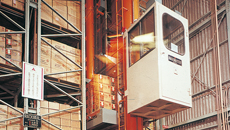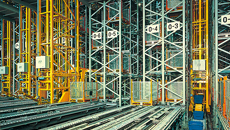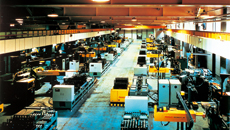History of Automated Warehouses at Daifuku
Daifuku developed the first automated storage and retrieval system (AS/RS) in Japan in 1966. The objectives for developing this system included achieving workload reductions and cost savings through (1) the effective use of land, (2) improvements in storage efficiency, (3) personnel saving and labor saving in warehouse work, and (4) improvements in management levels. At the time, single-story warehouses were standard type for warehouses. Logistics capabilities were not as advanced as current levels because loading, unloading, and storage work mostly consisted of manual labor, and stored goods were managed through ledgers and slips. The automated warehouse that emerged under these circumstances was a revolutionary logistics technology innovation that overturned the traditional concept of warehousing.
1970s: Spread of Systems Boosted by Increasing Adoption of Computer Technologies
As suggested by its name, automated storage and retrieval systems (AS/RS) are systems that allow warehouses to become three-dimensional and automated, and they had mostly been used for storing finished goods and raw-material by manufacturers until the beginning of the 1970s. Furthermore, because automated warehouses were not necessarily low-cost at the time and the breakeven level was high, the majority of customers were large companies.
In 1966, we delivered the Rackbuil System (rack-supported building with an AS/RS), which was operated onboard, to the Electric Motor Department of Matsushita Electric Industry (at that time) as the first automated warehouse in Japan. In addition, we commenced with unmanned operations of a stacker crane called Rack Master that enabled automated warehouse storage locations to be managed based on X, Y, and Z coordinates and could be operated easily with a computer. In 1969, we delivered the first fully automated Rackbuil System using computer control in Japan to the Nobeoka Plant of Asahi Chemical Industry Co., Ltd.
As a result of the possibility of controlling automated warehouses by computer, the accuracy of inventory management was improved, as inventory management could be done simultaneously with the retrieval and storage of materials. As a result, a sudden expansion of the industries adopting these systems began. For example, some of the largest automated warehouses in the world were delivered to the Kasuga Plant of Toyota Motor Corporation and the Sagamihara Parts Center of Nissan Motor Co., Ltd., which are both auto service parts centers that manage tens of thousands of items. In addition, automated warehouses were also adopted at pharmaceutical companies, mainly for the purpose of strengthening the accuracy of inventory management and storage and retrieval management.
From the mid 1970s, the effectiveness of automated warehouses began to become recognized in the market and demand grew for automated warehouses that were more economic and lower-priced than building-style systems. In response to these needs, we developed and commenced the sales of the technical standard-compliant unit load AS/RS and the superfast mini load AS/RS.

Photo 1: The first automated warehouse (Rackbuil System) in Japan

Photo 2: One of the world's largest (at the time) automated warehouse for auto parts management

Photo 3: What was called the world's most cutting-edge (at the time) machine tool FA plant
1980s: Adoption in a Wide Range of Fields
In the 1980s, capital investments in the manufacturing industry were active as the competitiveness of Japanese industrial products began to surpass those from Europe and North America. The applications of AS/RS also expanded from the past focus on finished goods storage to include production sites, including those electricity, electronics, and precision machinery manufacturing. These warehouses were used as equipment allowing interbay and intrabay initial setup, sorting with parts storage and supply capabilities, and buffer capabilities enabling 24-hour-a-day operation. Against this backdrop, interbay and intrabay automatic warehouses and automatic guided vehicles (AGV) were developed, along with production systems integrated all the way to production facilities with computers. We delivered our advanced factory automation systems to many leading companies that included Fanuc Corporation, Fujitsu Limited, and Makino Milling Machine Co., Ltd. Strong demand has continued to this day for flexible manufacturing systems for machining center developed during this period.
Meanwhile, finished goods storage systems were called on to fulfill a distribution center function. Many centers were built with higher levels of automation through combinations of AS/RS and various peripheral equipment that had been systemized. We delivered advanced distribution center systems to many companies including Toppan Forms Co., Ltd., Sangetsu Co., Ltd., and Yamanouchi Pharmaceutical Co., Ltd. At these distribution centers, the HQ information system and logistics center systems are connected by a dedicated line in an effort to achieve reductions in delivery lead time, delivery accuracy, and inventory management accuracy. In addition, it was around this time that we began exporting AS/RSs overseas, accompanying the global expansion of the Japanese manufacturing industry, which continues to this day.
Accompanying the combination of the economic environment and the lack of manpower from the mid-1980s, AS/RSs, which had mainly been delivered to large corporations, also became adopted by small and medium-sized manufacturers, and the market expanded at a rapid pace as a result. The spread of personal computers began to keep pace with these developments, and developing relatively inexpensive inventory management systems using personal computers and software packages became possible. With these developments, small-scale AS/RSs commonly conducted inventory management in sync with cargo storage and retrieval through computer control.
1990s: Emergence of Various High Capacity Systems
From the late 1980s and early 1990s, industries outside of manufacturing began adopting automated warehouses, including the agriculture, wholesale and retail industry, warehousing, bank, insurance, and public agencies. These industries did not have much previous experience with logistics automation, which led to a further expansion in the scope of the market. For example, in the field of agriculture, automated warehouses were used as depositories for unpolished rice, fruit refrigeration, cold refrigeration of pre-shipment vegetables, and mushroom culturing, as well as as sorting and shipping equipment at sorting facilities for fruits and vegetables.
In the latter half of the 1990s, systems began to be adopted at stages of distribution closer to end users. In the warehouse industry and wholesale and retail industry, automated warehouses were used as import bases for consumer goods, which was increasing with deflation, and within logistics center in order to fulfill supply chain management (SCM). At these distribution centers, mini load AS/RS, which are capable of handling cargo of a variety of shapes and sizes, were also adopted for purposes that differed from traditional storage functions, such as a high-capacity pre-shipping alignment or as initial setup for picking. At Daifuku we have developed higher capacity mini load AS/RS and expansion of transfer equipment variations to meet these needs. Furthermore, in 2002, we developed the high-capacity mini load AS/RS Magic Sorting System, which reduced the cycle time by about one-half compared to previous AS/RS, making it possible for mini load AS/RS to support the load handling speed of transit-type distribution centers.
In this manner, there has been an need meet demands for functions that match significant changes in the logistics environment. Also, with the ongoing aging of automated equipment that had been constructed in the 1970s to 1980s, there has been a demand to renew equipment.
Automated Warehouses for Special Environments
While the initial refrigerated storage AS/RSs were constructed during a brief period in the 1970s, construction was suspended due to the fact that profitability was low. However, profitability was improved with the progress of refrigeration technologies and changes in the social and logistics environment, and, as a result, construction demand grew for automated warehouses for industries, including food wholesaling and marine products processing, from the 1990s.
For hazardous goods warehouses, full-fledged construction of automated warehouses, with building areas of up to 1,000 m2 and height up to 20 m, became possible with the partial revision and enforcement of Japan's Fire Defense Law in 1990. It also became possible to construct many rack-supported building AS/RS, with an emphasis on storage capabilities, in this field for which small-scale unit-type AS/RS (interbay warehouses) had been mainstream in the past.
In semiconductor manufacturing, demand for high levels of cleanness within the manufacturing process grew with the increase in the level of integration. As workers were the largest source of dust within cleanrooms, it was necessary to adopt unmanned operations for interbay transport and interbay buffers. The cleanroom AS/RS Clean Stocker was developed as an interbay buffer and is currently in operation at many plants around the world, including those of major semiconductor manufacturers. In addition, this same technology has also been used in production lines for flat panel displays and OLED panels.
Enhancement of Peripheral Equipment, such as STVs and Robots
Initially, most peripheral equipment for automated warehouses were composed of conveyor lines. During the 1980s, external drive shuttle carts with a mechanical speed change mechanism were developed in an aim to improve speed and reliability of load handling. However, performance of processing capacity, horizontal traveling speed, noise during operation, and ease of maintenance did not meet the demands of the market. In order to resolve these issues, in 1987 the high-speed, high-capacity, extremely low-noise guided Sorting Transfer Vehicle (STV), which also has autonomous decentralized control, was developed. This enabled system standardization and improved reliability, reduced delivery time, and decreased cost. The current STV is an essential piece of peripheral equipment for AS/RS.
Picking work of cased units at distribution centers is necessary in order to support small shipments of products stored in pallet units. In the past, case picking work was often conducted manually. As this labor-intensive work also caused back pain, there was a major need for automation at distribution centers with frequent case picking. In 1995, a case picking system that combined robots and position recognition equipment using image processing was developed in response to these needs. A high-performance system linked with AS/RS was established and delivered to clients, such as beverage manufacturers, which have high volumes of case processing.
As our AS/RSs have become more sophisticated, we have expanded the range of system variations and features to suit various needs and applications. We have also been working on the provision of eco-products that take environmental impact into consideration.
Daifuku will continue listening attentively to the demands of customers as we do our utmost to establish new, more optimal systems together with our customers.
Related links
Automated Storage & Retrieval System (AS/RS)Contact Us
For product inquiries, please reach out to us via our Contact Us page.
Contact UsContact Us
For product inquiries, please reach out to us via our Contact Us page.
Contact Us